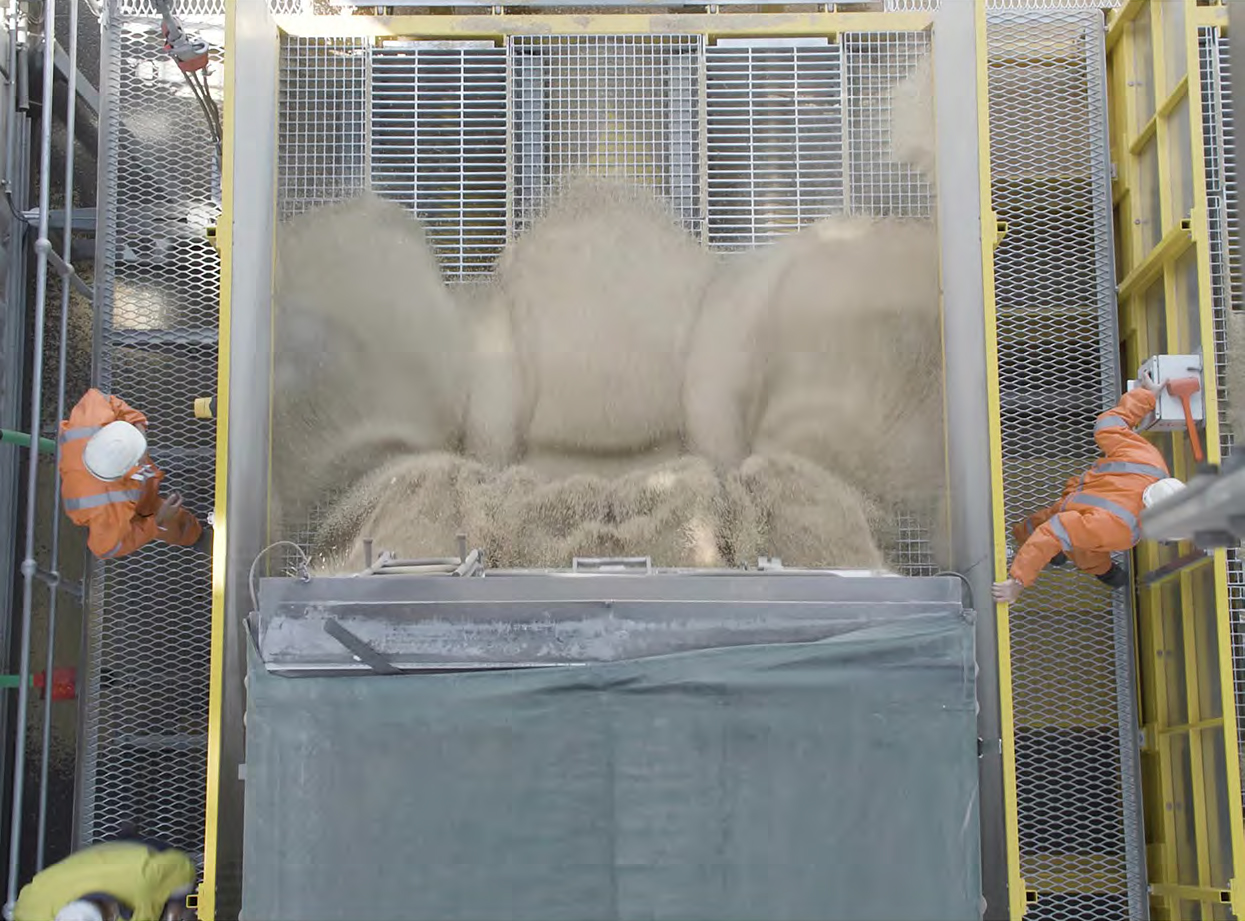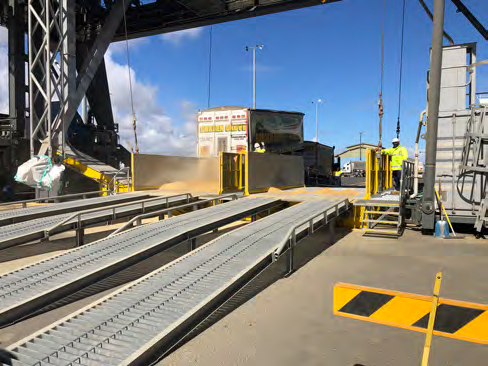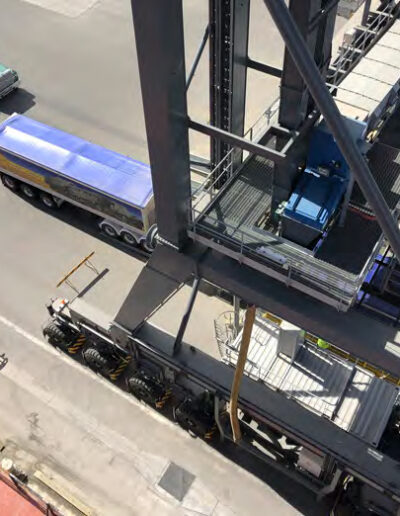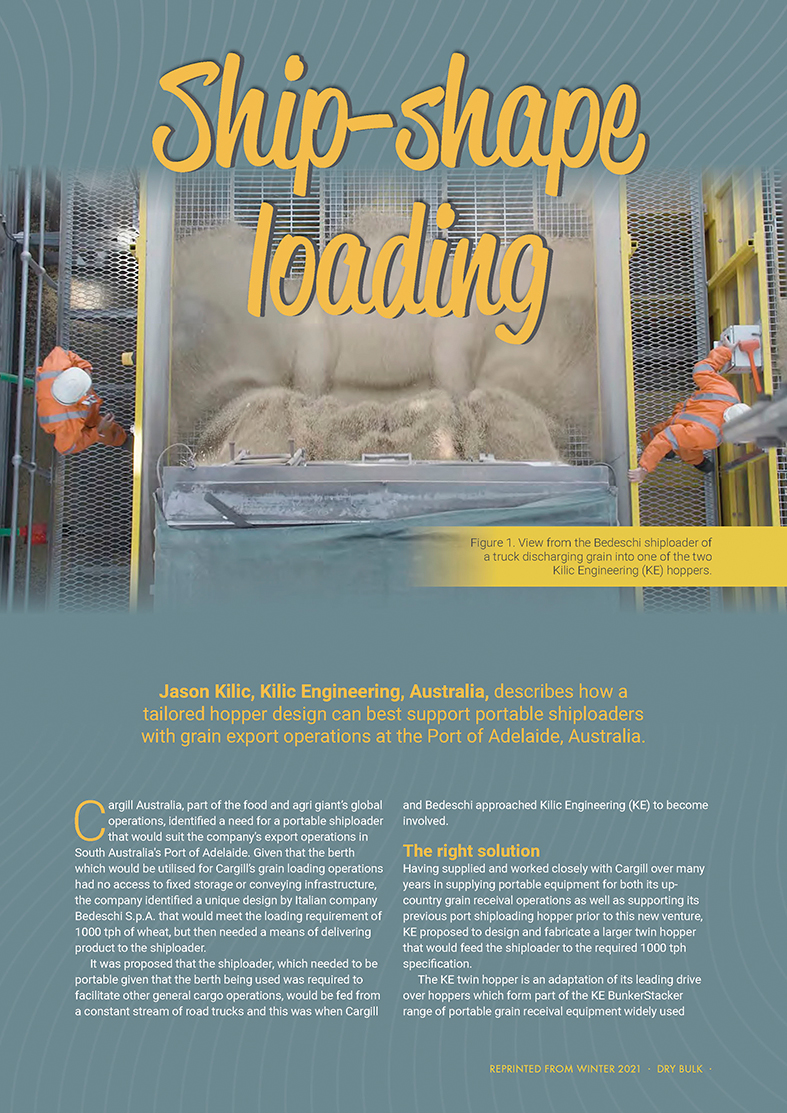Ship-shape loading
Dry Bulk Magazine
Jason Kilic, Kilic Engineering, Australia, describes how a tailored hopper design can best support portable shiploaders with grain export operations at the Port of Adelaide, Australia.
Cargill Australia, part of the food and agri giant’s global operations, identified a need for a portable shiploader that would suit the company’s export operations in South Australia’s Port of Adelaide. Given that the berth which would be utilised for Cargill’s grain loading operations had no access to fixed storage or conveying infrastructure, the company identified a unique design by Italian company Bedeschi S.p.A. that would meet the loading requirement of 1000 tph of wheat, but then needed a means of delivering product to the shiploader.
It was proposed that the shiploader, which needed to be portable given that the berth being used was required to facilitate other general cargo operations, would be fed from a constant stream of road trucks and this was when Cargill and Bedeschi approached Kilic Engineering (KE) to become involved.
The right solution
Having supplied and worked closely with Cargill over many years in supplying portable equipment for both its up-country grain receival operations as well as supporting its previous port shiploading hopper prior to this new venture, KE proposed to design and fabricate a larger twin hopper that would feed the shiploader to the required 1000 tph specification.
The KE twin hopper is an adaptation of its leading drive over hoppers which form part of the KE BunkerStacker range of portable grain receival equipment widely used across the Australian grain industry to fill above ground bunker type grain storages.
KE is not new to developing above ground drive over hopper systems to facilitate road transport deliveries to vessels along a wharf or berth area. The company has been involved in two recent projects in Vietnam and Japan, where KE provided its customers with single hopper solutions to load grain from their drive over hoppers. In Vietnam, KE provided a complete shiploader solution with the drive over hopper feeding into a short elevator and then into the ship’s hold, whilst in Japan KE provided a hopper and stacker to load vessels with wood pellets.
KE’s concept of a two-lane, dual-drive over hopper to simultaneously receive product from two separate feeds was a simple solution to achieve Cargill’s desired loading rate of 1000 tph of wheat utilising KE’s existing technology and expertise.
However, KE had to ensure its solution needed to be not only strong enough to support two multi-trailer grain trucks unloading but it also necessitated the unit to be light enough to be carried around the Port by the Bedeschi shiploader – features that had immediate appeal to both Cargill and Bedeschi.
The Bedeschi shiploader design, which moves on a multitude of rubber tyres incorporating 14 twin wheel bogie sets rather than along fixed rail tracks on the berth, was further adapted to accommodate a dedicated steel rope lifting system attached to KE’s twin hopper set-up to enable efficient and rapid movement of the unit along the berth during shiploading operations.
The portability of the shiploader also allows it to be moved away from the berth when not being used for loading operations to a dedicated parking area. This area has been designed with tie down capability to ensure the machine is secured during rough weather conditions as well as providing an ideal location for maintenance and cleaning functions to take place.
To support the Bedeschi shiploader design, two of KE’s drive over hoppers were fixed together, with each unit providing a minimum discharge capacity of 500 tph of wheat. The dual hopper structure sits just 800 mm (31 in.) above ground level with each hopper having a 6 m (19.6 ft) long dump area to receive the product as it is being tipped from the road transport trucks. Trucks access and exit the hoppers via 9.3 m (30 ft) long ramps at each end.
Four sets of dual augers feed the grain into the centre of each hopper where it then transfers to a 1200 mm underbelly conveyor belt which takes the product to the Bedeschi elevator legs feeding the shiploader.
Two operators, one on each of the hoppers, regulate the flow of grain to the hopper underbelly belt and then into the shiploader elevation legs, utilising lanyard controllers to maximise the discharge from the road trucks and provide continuous flow into the vessel.
Rising to the challenge
From KE’s perspective, development of the concept came with some risk of course. The mechanical, electrical, and hydraulic technologies all had to be designed to integrate with the Bedeschi machine as well as meet Cargill’s exacting standards of safety and performance. Collaboration was the key to mitigating this risk, with the design effort spread between Italy and Australia and components being sourced from a global supply chain.
KE was confident this was going to be a challenge the company would meet. Jason Kilic, KE’s Managing Director, said “Our team have been delivering material handling technology to the agricultural sector since the company was started by Tony Kilic in 1975. It has been thoroughly rewarding to find that our knowhow can add value to the operations of a global grain handler as well as supplement the knowledge of material handling specialist Bedeschi. It was also great to have Cargill’s confidence throughout the project.”
“I have used KE equipment for the past six or seven years at Port Adelaide and always found it to be reliable,” said Corey Johnstone, Cargill’s Port Manager in South Australia. “It is great that we can utilise KE’s local engineering expertise and equipment to support our new Bedeschi shiploader and enable Cargill to provide a more efficient and competitive export path for our customers out of South Australia”.
The KE dual hopper equipment was designed, manufactured, fully assembled, and tested at the KE facility in Australia before being broken down for transport to the Port.
During the build, things started to get interesting. The outbreak of COVID-19 saw international travel restricted which challenged global operators that were used to mobilising expertise to complete equipment deliveries and execute vital commissioning and training tasks. With the lockdowns hindering supply of equipment and human resources, Bedeschi needed help to unload, deliver, integrate, and commission the shiploader at the Port of Adelaide.
Out of a competitive bidding process, KE won the opportunity to get the whole system up and running for Cargill at the Port. Against a tight timeframe that spanned the Christmas and New Year holiday period, the KE crew worked long hours to unload and assemble the Bedeschi shiploader which had been transported from China, as well as integrate the KE double-lane drive over hopper.
Jason was nervous. “Cargill had grain on standby and a ship booked to be loaded so we had to have the machine ready for operation with enough time to achieve approval from the Australian Quarantine and Inspection Service. It was tight but we made it thanks to the dedication of the KE crew, tremendous support from Bedeschi, and Corey and the team from Cargill being part of the process through every step.”
The Bedeschi machine with its KE twin hopper is now a permanent part of Cargill’s operations at the Port with the technology continuing to be supported by KE.
Conclusion
Since its commissioning in late 2020, the Cargill shiploader has loaded more than 12 vessels (totalling over 300 000 t) of grain products including barley, wheat, and canola prior to the upcoming 2021/2022 South Australian grain harvest.
The quality of the construction of the KE hoppers has resulted in very little downtime being experienced during this time, a tribute not only to the KE team but also to the contributions of its local suppliers including Tristar Electrical, BL Shipway, CavPower, and SEW Eurodrive. The strong partnerships that KE has developed with its suppliers over many years have resulted in KE’s drive over hoppers being constantly refined to become the most robust and reliable portable grain handling equipment in the Australian market.
The concept developed between Cargill, Bedeschi, and KE of providing a portable set of delivery hoppers to feed the shiploader at the Port of Adelaide with loading rates of up to 1000 tph opens up the opportunities for other ports across the globe to utilise similar technology where there is either limited wharf access and/or a lack of silo or shed type storages at the berth.
KE is now actively involved in developing concept designs for other grain export operators for the provision of alternative shiploader solutions to the Bedeschi travelling shiploader, utilising the KE direct road transport delivery drive over hopper system constructed for Cargill at the Port of Adelaide. Shallow ports with limited berth space require different options to traditional shiploader designs, and KE’s long history of finding solutions for its customers is now at the forefront of its growth strategy to provide bespoke shiploader options to the agri industry going forward.
Dry Bulk, November 2021
Click on the image to view the original article as a PDF.






